Research Results
Self-replication or cell differentiation?
Controlling neural stem cells with light FY2017
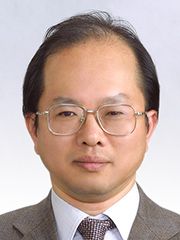
- Ryoichiro Kageyama (Professor,Institute for Frontier Life and Medical Sciences, Kyoto University)
- CREST
- Research into the "The Dynamic Mechanism of and Fundamental Technology for Biological System" Research published on the "Mechanism of ultradian rhythms of gene expression" (2006-2011)
Research into the "Creation of Fundamental Technologies for Understanding and Control of Biosystem Dynamics" Research into the "Elucidation and control of dynamics of oscillatory gene expression in cell proliferation and differentiation" (2012-2017)
Solving the mysteries of neural stem cells will make regenerative medicine possible
The neural cells that make up our brains are produced from the cells, called neural stem cells, during the fetal stage. These cells are capable of self-regeneration and have the ability to differentiate into the three main types of cells that make up the brain: Neurons, astrocytes, and oligodendrocytes. This means that neural stem cells have two entirely different capabilities: Self-regeneration (making copies of themselves without differentiation) and multipotency (the ability to differentiate into a number of different cell types).
It was not understood, however, what kind of mechanism allows neural stem cells to possess both self-replication and multipotency capabilities and what kind of mechanism causes them to select one of the three cell types (cell fate determination). Elucidating these mechanisms will not only lead to elucidation of the cerebral nervous system' s developmental mechanism but also provide the fundamental knowledge required for regenerative medicine for treating brain damage and neurodegenerative disorders.
Previous research has shown that certain kinds of protein (bHLH transcription factors) are involved in controlling the self-regeneration and cell differentiation of neural stem cells. The protein "Hes1" controls the maintenance of undifferentiated neural stem cells and differentiation to astrocytes, the protein "Ascl1" controls differentiation into neurons, and the protein "Olig2" controls differentiation into oligodendrocytes. The mechanism by which these proteins cause neural stem cells to self-replicate and differentiate was not understood, however.
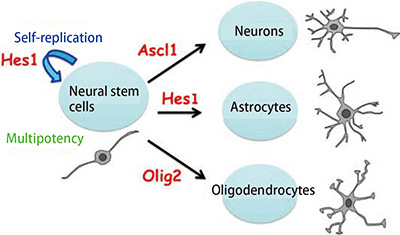
Neural stem cells are able to self-replicate and have the ability to differentiate into a number of different cell types.
The key is the fact that the three proteins oscillate
"Strategic Basic Research Programs"(CREST), JST were established as strategic targets to meet the nation's social and economic needs, and feature strong teams of researchers specialized in a number of fields working on research to help facilitate the policies of the Japanese government.
As part of their research in a CREST project, Ryoichiro Kageyama and his team developed glowing proteins by integrating the three proteins Hes1, Ascl1, and Olig2, with luciferase, a luminescent protein found in fireflies. Using these glowing proteins, they produced genetically modified mice to observe and analyze protein expression dynamics. Through doing so, they found that the three proteins increase and decrease cyclically. Hes1 and Ascl1 are expressed in two- to three-hour cycles (or expression oscillations) while Olig2 is expressed in five- to eight-hour cycles.
Professor Kageyama and his team then carried out experiments where levels of one of the three proteins were reduced. They found that this reduced neural stem cell replication. Based on this they hypothesized that vibration of multiple cell fate determinants enabled cells to remain undifferentiated and self-replicate while retaining their multipotency. The team then analyzed how the three proteins were expressed when neural stem cells differentiated. They found that there was an accumulation of Ascl1 when the cells differentiated into neurons, an accumulation of Hes1 when differentiating into astrocytes, and an accumulation of Olig2 when differentiating into oligodendrocytes. They hypothesized that when cell differentiation is induced, expression of one of the three proteins increases to promote cell differentiation.
The experimental results indicated that by altering expression dynamics the same determinant can activate neural stem cell self-replication and induce differentiation into a certain type of cells. For example, when Ascl1 carries out expression oscillation it activates self-replication of neural stem cells and when it accumulates it induces differentiation into neurons. The team garnered attention from around the world for elucidating in this way the mechanism behind how neural stem cells are turned into stem cells through the combination of self-replication and multipotency.
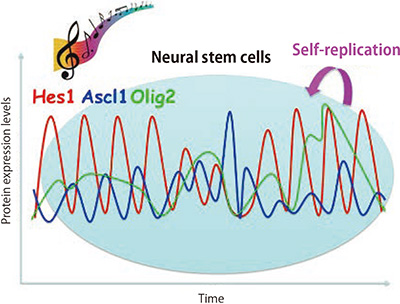
he expression of Hes1, Ascl1, and Olig2 oscillates in neural stem cells.
Using light to control the proliferation and differentiation of neural stem cells
Using hGAVPO, a protein that responds to light, Professor Kageyama and his team were also able to artificially control the expression dynamic of Ascl1. During an experiment, they illuminated blue light every three hours to cause Ascl1 to oscillate, and every 30 minutes to induce neural stem cells to accumulate Ascl1.
Illuminating neural stem cells with blue light to induce three-hour-cycle expression oscillations of Ascl1 promoted self-replication. Additionally, when accumulation of Ascl1 was induced, differentiation into neurons was also induced. In this way, Professor Kageyama and his team succeeded in developing a revolutionary method of artificially manipulating the proliferation and differentiation of neural stem cells simply by changing the blue light illumination patterns, without the use of chemical compounds or exogenous proteins.
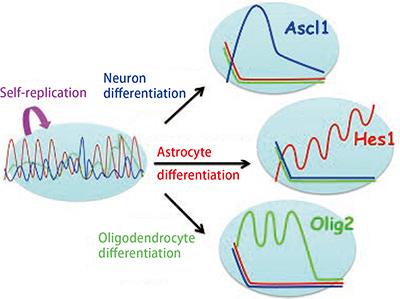
At the time when the differentiation fate of neural stem cells is determined, the expression level of one of the three repeatedly oscillating proteins (Hes1, Ascl1, or Olig2) increases, while the expression levels of the other two proteins decrease.
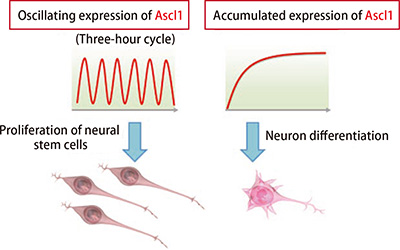
When genetic expression control technologies were used to induce three-hour-cycle expression oscillation of Ascl1, cell proliferation was promoted. When there was accumulated expression of Ascl1, differentiation into neurons was induced.
Working toward treatment for Alzheimer's disease and other nerve cell disorders
It is hoped that technologies allowing the use of light to control the inducement of neural stem cell self-replication and differentiation into neurons will contribute to research into regenerative treatment of patients with brain damage and neurodegenerative disorders. There is also a possibility that such technologies may be applicable to neural stem cells inside the brain, and it is hoped that it may lead to treatments for nerve cell-related disorders such as Alzheimer's disease and depression. Expression of the protein Hes1 has been confirmed not only in neural stem cells, but also in most other stem cell types including pluripotent cells (embryonic stem cells and iPS cells), hematopoietic stem cells, and skin stem cells. The control mechanism based on expression oscillations of cell fate determinants found during this research is believed to be a mechanism employed universally by other stem cell types and the discovery is expected to have wide-ranging ripple effects across stem cell research in general.
